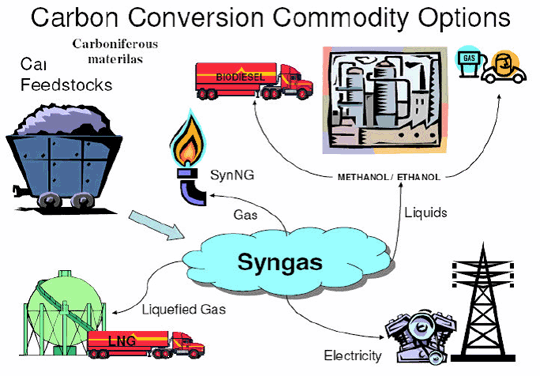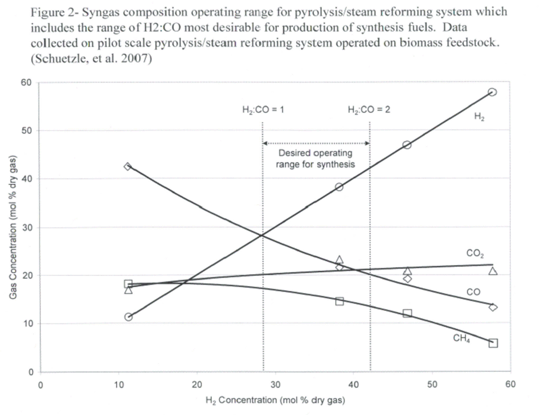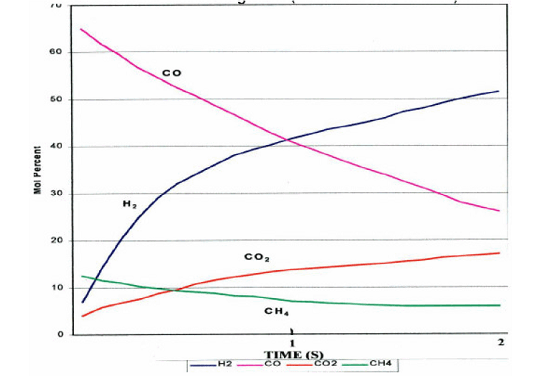Theory of the technology
It incorporates several new technological developments and design features such as:
- modular construction and shop fabrication;
- no requirement for refractory brick;
- no requirement for separation and injection of oxygen;
- no sensitivity to moisture content in the feedstock;
- no requirement for pulverization or slurry injection of feed;
- flexibility in feedstock alternatives including varying proportions of coal, pet coke, biomass, sewer sludge or other organic waste in different proportions;
- utilization of a unique ionized water treatment system;
- capability of recycling un-reacted carbons back into the reactor chamber, and a near-zero air emissions and liquid discharge.
In addition, some of the carbon dioxide generated in the gasification process can be captured and recycled as feedstock. Further the potential exists to readily integrate this system into a portable, flexible gas-to-liquids bio-refinery. There is substantial commercial potential in the TCG unit.
During the last years, many novel design aspects have been further developed that culminated in a US patent filed on April 11, 2006, application No: 60 / 791,401.
The „TCG-UC System” covers the whole problem area, offering the total solution from the grinding machine, via the TCG Unit, to the „SECU” - SynGas-Electricity energy Conversion Unit (Gas motors or Turbines,) - to the „LFU” - Liquid Fuel Unit (Fischer-Tropsh or Diesel Liquefaction) with a specific readyly available additional equipments.

A solid carbonaceous material synthesis (100 million BTU/h) gas generation plant (gasifier) was built on a test site. This commercial scale reference plant was completed in mid-August 2007. Currently conducting operational start-up activities at the University of Toledo, Ohio. The plant is designed to utilize carbonaceous feedstock from coal to biomass including wood chips, rice straw, ethanol plant DDGS, and municipal and industry waste products (i.e. organic sludge, industry waste, petroleum coke) for synthesis gas production. The plant feed system is designed to handle blended feedstocks, including coal mixed in any proportion, with the above mentioned materials.
The unique capability of the plant for utilizing a mixed fuel of coal and biomass in any proportion may provide synthesis gas composition from H2:CO=1:1 to H2:CO=1:3 which is most desirable for production of synthesis fuel, such as ethanol, mixed alcohols, diesel, gasoline, and jet-fuel. (Schuetzle, et al. 2007)

The quantity of the components of SynGas depending on the pressure and temperature in the pyrolysis chamber and the time length while that the feed materilal is staying in it.

A small group of experts and scientists, - led by a brilliant mining engineer, Mr. M.Wiley (RIP) - has developed the TCG, this Worldwide patented technology, that provides the best environmentally friendly solutions. It can utilize any organic material, like waste materials, or fossil energy source materials, - like different coals, oil refinery residuals, and others, - as feedstock.
Moreover it is able to use the flue gas of the traditional, high-emission, coal-fired power plants, as an additional feed material, and building its recombined elements, into the produced “Syngas”.
This technology is the only solution for the following, most important issues of the environmental protecting:
- the fossil energy sources, can be used again in the electricity manufacturing, due to the near zero emission of the TCG technology,
- using the flue gases of the traditional, coal/oil fuelled power plants as feedstock, the emission of the CO2, and other GHG are decreased,
- the 100% of the organic part of MSW can be eliminated in the Near-Zero-Emission (NZE) TCG-UC Green Energy Centers, in “green electric energy” production process,
- the coal mining industry could be “re-born”, using this NZE-CCT (Clean Coal Technology),
- several other issues that can also be solved by using this very effective and green technology, Worldwide.
The recently-perfected Thermo-Chemical Gasification (TCG) technology is able to provide an unparalleled solution to remedy these problems by utilizing both the fossil energy source materials and the waste material as feedstock to generate/manufacture synthetic gas with high efficiency and near zero emissions, which can be utilized directly as fuel gas to generate electricity in gas motor/turbine generator set (GenSet) or itself further processed as a feedstock to produce hydrocarbons such as ethanol, methanol, bio-diesel or synthetic natural gas (SNG) through the application of the well-known Fischer-Tropsh catalytic converting system.
TCG technology is not merely one solution among the many, but it is that special solution that provides the best presently available answer to the problems associated with - the environmental contamination problems that the presently huge levels of urban waste the millions of used tires, the almost unmanageable organic industrial waste handling and remediation - creates for society. TCG plants emit no harmful or toxic contaminants, the processing units have no chimneys, therefore during the conversion of the carbonaceous materials into energy, the system has no material emissions into the environment.
TCG technology is capable of converting any carbonaceous (organic) materials (such as organic sludge; municipal solid waste; biomass; energetic woods or grass; used tires; distillate, oil refinery, or paper-industry residues; fossil materials, or any mix of these materials) into a synthetic gas whose composition is well-controlled without the uncontrolled emission of gas or liquid materials into the environment. The produced synthetic gas (SynGas) can be used directly in gas motor/generator sets to generate electricity or serve as the feedstock for producing methanol, ethanol, diesel, Jet Fuel, synthetic natural gas etc.
The TCG - allows high temperature thermo chemical gasification without oxygen and air.
It incorporates several new technological developments and design features such as:
- modular construction and shop fabrication;
- no requirement for refractory brick;
- no requirement for separation and injection of oxygen;
- no sensitivity to moisture content in the feedstock;
- no requirement for pulverization or slurry injection of feed;
- flexibility in feedstock alternatives including varying proportions of coal, pet coke, biomass, sewer sludge or other organic waste in different proportions;
- utilization of a unique ionized water treatment system;
- capability of recycling un-reacted carbons back into the reactor chamber, and a near-zero air emissions and liquid discharge.
In addition, some of the CO2 - generated in the gasification process, or generated from external sources, - can be captured and recycled as feedstock. Further the potential exists to readily integrate this system into a portable, flexible gas-to-liquids bio-refinery.